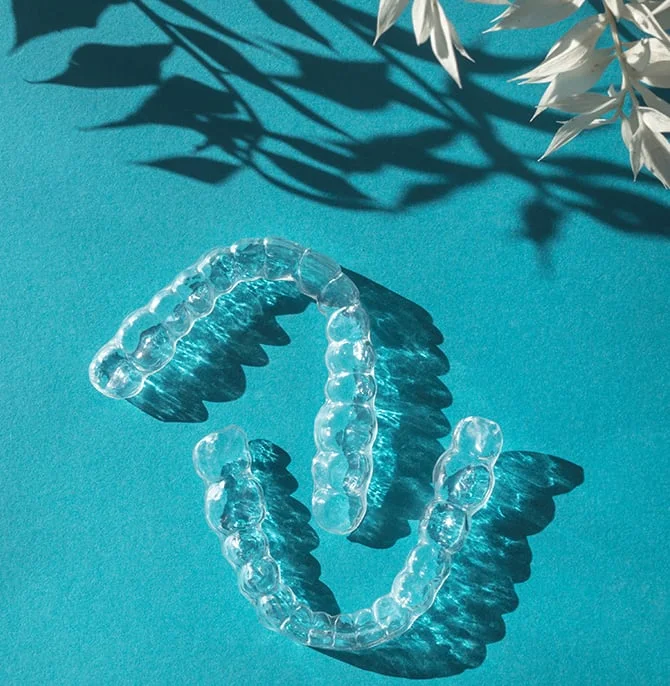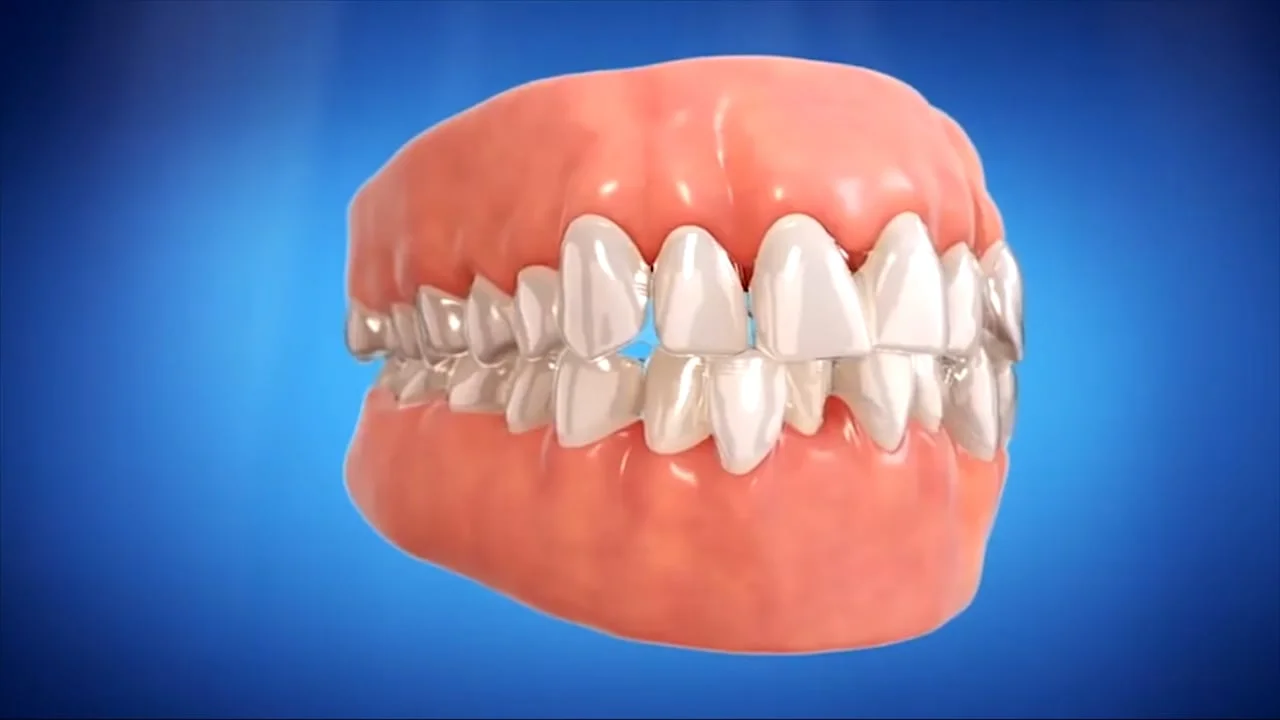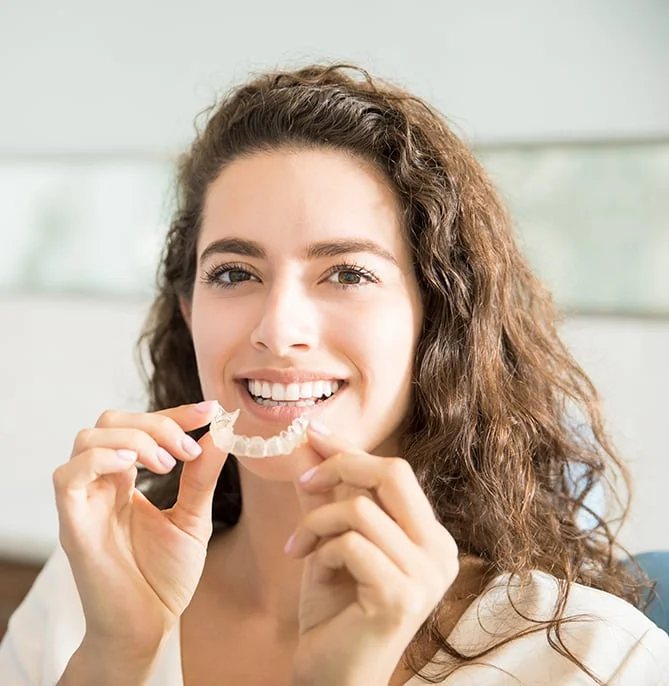Receive $1,000 off your braces or Invisalign treatment!
Choosing an experienced and qualified orthodontist is important when considering Invisalign® treatment. Orthodontists are specialists in procedures designed to straighten the teeth, correct bite and jaw alignment, and enhance the appearance of your smile. Our highly skilled New York orthodontist, Dr. Nikhil Narkhede, has gone through extensive Invisalign® training. He has completed a three-year postgraduate residency in Orthodontics & Dentofacial Orthopedics at the New York University College of Dentistry, and regularly attends continuing education courses on the latest orthodontic techniques. His education and training in Invisalign® allow him to provide you with an effective treatment plan that can help you achieve the best possible results.
- What is Invisalign®?
- Invisalign® Benefits
- Invisalign® Candidates
- Invisalign® vs. Braces
- How Invisalign® Works
- Invisalign® Treatment
- Invisalign® Teen
- Wearing Invisalign® Aligners
- Invisalign® Results
- Invisalign® Care
- Invisalign® Longevity
- Invisalign® Cost
- Invisalign® Complements
- Invisalign® Alternatives
- Top Invisalign® Dentist
- Invisalign® FAQs
- Virtual Orthodontic Consultation
What is Invisalign®?
Invisalign® clear teeth aligners offer a revolutionary way to straighten teeth and correct over- and underbite issues without having to wear traditional metal braces. This innovative treatment utilizes a system of clear aligners that are removable, comfortable, and virtually invisible. Many patients who have Invisalign® achieve optimal results in less time than it takes with other methods of orthodontics. With the expertise of Dr. Nikhil Narkhede as well as our lead dentist, Victor Oelbaum, DDS, our team of skilled dental care professionals can help you attain an even, beautiful smile through discreet and comfortable treatment.

What are the Benefits of Invisalign®?
Metal braces can not only be aesthetically displeasing, but they can also be somewhat difficult to deal with and uncomfortable to wear for such an extended period of time. As a cutting-edge treatment in orthodontics as well as cosmetic dentistry, Invisalign® offers many of the same straightening benefits as traditional braces while relieving the inconveniences of wires and metal brackets on the teeth. Benefits of Invisalign® include:
- Virtually invisible straightening system
- Removable for eating, drinking, and oral hygiene regimens
- No broken wires or other problems associated with braces that may necessitate an office visit for fixes and adjustments
- Commonly takes less time to achieve optimal results than other treatments


Invisalign® vs. Braces
Not only can Invisalign® straighten teeth without the obtrusiveness of metal braces, but this clear orthodontic system typically achieves a patient’s treatment goals in a faster time period than traditional techniques. Wearing Invisalign® aligners instead of metal braces may also provide benefits to one’s oral health, as the removable appliances often make it easier for patients to thoroughly clean their teeth and gums. This can decrease the chances of gum disease and bacteria buildup, which generally arise when food particles are not properly removed from between wiring and metal brackets. The aligners also eliminate the possibility of metal wires poking and irritating the gum tissue, reducing the likelihood of gum swelling and inflammation.
Invisalign® aligners also allow patients to eat any type of food, including popcorn, caramel, and taffy, while metal braces typically restrict sticky or chewy foods from one’s diet. Best of all, Invisalign® can address most of the same issues as traditional braces, such as biting problems and misalignments, at a comparable cost. Dr. Narkhede will evaluate your concerns and suggest the best orthodontic treatment to straighten your smile and fulfill your dental goals.
How Does Invisalign® Work?
Invisalign® is designed to correct occlusion and misalignment issues by using gentle and gradual force, applied over an extended period of time, to guide teeth into the proper positioning. Made from clear thermoplastic material, clear Invisalign® aligners are fabricated in a design that resembles teeth-whitening trays. These customized aligners are used to gently and systematically move teeth in minor increments until the desired result has been achieved.
Is Invisalign® Right for Me?
Invisalign® can be an excellent and highly effective system to straighten your smile if you’re looking for a more cosmetic treatment option than braces. Invisalign® aligners can also be ideal if you wish to avoid the irritation and discomfort often associated with metal brackets and wiring. Using clear, thermoplastic aligners, Invisalign® can correct many of the same orthodontic concerns as braces, including:
- Underbites
- Overbites
- Cross bites
- Open bites
- Teeth crowding
- General misalignments
For some patients, Invisalign® can also help alleviate some of the symptoms of TMJ disorder (TMD). This condition is caused by jaw joint dysfunction, and often leads to burdensome symptoms such as jaw pain, a ringing in the ears, or a clicking sound when opening and closing the mouth. Depending on the mechanisms causing TMJ dysfunction, Invisalign® has been known to reduce TMD symptoms by addressing malocclusion and realigning an individual’s bite.
Only after a consultation with our board-certified orthodontist can our team confirm that you would benefit from treatment with Invisalign®. These clear, invisible braces are also commonly incorporated into full mouth restoration for patients who have several different dental concerns they’d like to improve.

The Invisalign® Treatment Process
The Invisalign® procedure begins with an impression of your teeth taken by Dr. Victor Oelbaum here at our practice. Based on this impression, the Invisalign® clear teeth aligners will be custom-designed for your teeth to achieve the most accurate fit possible. After the aligners have been made, you will receive a series of Invisalign® trays that you will wear over the course of the treatment period. Once every two weeks, you will discard the set you are wearing and replace it with the next tray in the series. Each set is a bit different from the last one, ensuring a gradual progression of teeth realignment over a period of about 9 to 15 months. Although the Invisalign® clear teeth aligners should be worn consistently throughout the day, they are completely removable and can be taken out for daily brushing, flossing, eating, and drinking as directed by your Orthodontist.
You may experience a slight lisp during the first few days of wearing your aligners, but once you get accustomed to how they feel in your mouth, any lisp you may have formed should dissipate. When you have completed your Invisalign® treatment, you should have much straighter teeth and a beautiful new smile!
Choosing an Invisalign® Orthodontist Versus a Dentist
What is Invisalign® Teen?
 The Invisalign® system can also achieve excellent results for teens and adolescents. Invisalign® Teen generally involves the same process as standard Invisalign® for adults, but the treatment length may vary slightly since the teeth of younger patients are still developing. In any case, Invisalign® is usually the preferred orthodontic technique for teens due to the inconspicuous nature of the aligners. Patients can take selfies and pictures with confidence, as well as play sports and engage in recreational activities with a greater level of comfort than metal braces typically provide. Please inquire with Dr. Narkhede or a member of our team to learn more about how Invisalign® can help younger individuals who require teeth straightening or correction of overbite/underbite issues.
The Invisalign® system can also achieve excellent results for teens and adolescents. Invisalign® Teen generally involves the same process as standard Invisalign® for adults, but the treatment length may vary slightly since the teeth of younger patients are still developing. In any case, Invisalign® is usually the preferred orthodontic technique for teens due to the inconspicuous nature of the aligners. Patients can take selfies and pictures with confidence, as well as play sports and engage in recreational activities with a greater level of comfort than metal braces typically provide. Please inquire with Dr. Narkhede or a member of our team to learn more about how Invisalign® can help younger individuals who require teeth straightening or correction of overbite/underbite issues.
How Long Should Each Invisalign® Aligner Be Worn?
Each set of aligners should be worn for two weeks, and then discarded and replaced with the next set in your customized series. While they are removable, wearing your aligners for at least 20 to 22 hours a day can typically maximize your results and decrease the likelihood of a prolonged treatment time. Your orthodontist will provide you with more specific instructions regarding your personalized Invisalign® plan.
How Long Does Treatment with Invisalign® Take?
The length of your treatment will depend on your specific needs, but the average Invisalign® case takes about 9 to 15 months to complete. Many patients can achieve their teeth-straightening goals within 12 months, although this will depend on whether your concerns involve misalignment or occlusion issues (or both) as well as how consistently you wear your aligners.
“I have been coming to this office for 6 months for invisalign. The office is clean, professional, and timely. They are helpful in answering questions or concerns, and they are great at what they do! I am extremely happy with my results so far, and would recommend this office to any one!”
How Do I Care For My Invisalign® Aligners?
While your aligners must be removed when eating food, they can be left in while drinking most liquids. However, you may need to rinse your mouth and the aligners afterward. We recommend using a straw for any liquid other than water. To clean the aligners, simply run them under lukewarm water while gently scrubbing them with a toothbrush.
Will My Invisalign® Results Last Forever?
Invisalign® results should remain stable for a lifetime as long as you continue to wear your retainers at night. Without regularly wearing a retainer, it’s not uncommon for your teeth to potentially shift out of place after your Invisalign® treatment plan is complete. This can negatively affect your bite, create additional misalignments, or even facilitate the need for orthodontic treatment in the future. For this reason, Dr. Narkhede and our team recommend consistently wearing your aligner on a nightly basis to maximize the outcome of your treatment and ensure results last as long as possible. Maintaining excellent oral hygiene and staying up-to-date with your semi-annual dental appointments can also help keep your smile straight, healthy, and beautiful.
How Much Does Invisalign® Cost?
The cost of Invisalign® will be dependent on the extent of your needs, as well as the number of aligners necessary to straighten your teeth. Our team will provide you with a personalized quote once you are examined during a consultation. To make the expenses associated with Invisalign® more affordable, we accept several dental financing options, including credit card and CareCredit®. We also offer discounts for treatments paid in full and various insurance plans.
Complements to Invisalign®
There are a multitude of cosmetic treatments that can beautifully complement your Invisalign® results. Once you achieve a straighter smile and a more aligned bite, enhancing the outcome with professional teeth whitening — a convenient in-office treatment that typically takes no longer than one hour — can brighten your smile by several shades almost immediately. Results are often noticeable right after your in-office treatment, or can become visible over time with take-home whitening trays. In any case, teeth whitening can act as the last step in your journey towards gaining a more luminous smile.
For patients who may be interested in several cosmetic treatments, Invisalign® can also be implemented into a larger Smile Makeover. This treatment plan combines popular options like Invisalign®, teeth whitening, porcelain veneers, and more depending on your unique needs to ultimately achieve your dream smile. Since a Smile Makeover is personalized for each patient to obtain their desired results, no two treatment plans look exactly the same. We encourage you to communicate your goals to our dental team so we can recommend the best solution to treat your concerns.
Are There Alternatives to Invisalign®?
While Invisalign® can beautifully straighten your teeth, your concerns may be better addressed with other treatment options like porcelain veneers and traditional braces. If you have a minor misalignment affecting individual teeth, you may be able to achieve your goals with a porcelain veneer — a thin porcelain shell placed over the fronts of the teeth to mask minor cosmetic flaws. Usually completed in just two office visits, treatment with porcelain veneers can correct misalignments and provide a more symmetrical smile. However, veneers may not be the best solution for individuals who have malocclusion, or issues with their bite.
In other cases, traditional braces may be the most effective option for your needs. Although traditional braces are more noticeable than Invisalign®, our orthodontist utilizes modern materials such as ceramic to make your treatment more discreet and comfortable. Dr. Narkhede can evaluate your concerns and let you know what to expect during the teeth-straightening process.
Why Choose Oelbaum & Kagan Dentistry to Straighten Your Teeth?
We understand that you have many choices when it comes to finding an Invisalign® dentist in the Bronx and NYC areas. In selecting a qualified dental practice to provide orthodontic care for you and family, we encourage you to choose a dentist equipped with:
- A multispecialty dental team: During the process of correcting your smile and bite, it’s not uncommon to incorporate other cosmetic and restorative dentistry treatments if necessary. Our team is composed of in-house dental specialists who can collaborate during every stage of your treatment, streamlining and expediting your experience without the need for outside referrals.
- Before-and-after photos: While every orthodontic plan is personalized according to the goals of each patient, our smile gallery can be a great example of the dazzling results you can come to expect after Invisalign® treatment.
- Top-notch patient care: At Oelbaum & Kagan Dentistry, we consider our patients to be family. No matter what your needs and concerns may be, our team is committed to providing gentle and compassionate care during your treatment. Please feel free to read our online reviews to discover how we maintain such high rates of patient satisfaction.
- Modern technology: From digital impressions and 3D imaging to the use of advanced lasers and the OPMI® Pico Dental Microscope, our practice strives to keep up-to-date with new dental technology that can make your visit as efficient, comfortable, and timely as possible.
Additional Invisalign® FAQs
Do DIY braces work?
Also known as mail order braces, DIY refers to “do-it-yourself” teeth straightening systems marketed to correct orthodontic concerns without having to schedule dental appointments. Unfortunately, undergoing orthodontic treatment without the direct supervision of a certified dentist comes with significant risks to a patient’s smile, oral health, and orofacial physiology. Braces are not only designed to straighten crooked teeth — they also aim to realign the upper and lower jaws, which can affect your bite and entire facial structure. Without a qualified dentist or orthodontist to design your treatment plan and personally monitor your progress, patients risk exacerbating their concerns and potentially creating problems that require more time, expense, and invasiveness to repair. Needless to say, a DIY approach to orthodontics can be ineffective at best and outright dangerous at worst.
Can I straighten just my top or bottom teeth?
While your treatment plan will ultimately be developed based on your individual needs, straightening your smile as a whole is generally the best approach to orthodontic treatment — particularly if you exhibit an over- or underbite. Since the upper and lower jaws work together to form your bite, adjustments made to one dental arch will likely require accommodations to the opposite row of teeth in order to preserve proper alignment of the jaws. Consequently, treating only one row of teeth may not be the best approach to facilitate a comfortable and healthy bite. Dr. Narkhede will be able to determine the most optimal orthodontic plan to address your concerns when he evaluates your oral structures in person.
Do Invisalign® aligners stain?
Invisalign® braces are not immune to staining agents, so failing to rinse after eating — or drinking dark beverages while your aligners are in place — can certainly discolor the thermoplastic. If your aligners begin to stain, this can compromise the inconspicuous nature of treatment as well as prolong the amount of time it takes to straighten your teeth. For these reasons, we advise patients to remove their aligners when drinking anything other than water, particularly when consuming coffee, wine, cola, or other sugary beverages.
Does Invisalign® hurt?
One of the main benefits of Invisalign® is that the aligners offer a much more comfortable orthodontic treatment when compared to metal braces! There are no wires and brackets poking and irritating the gum tissue, and there’s no need to tighten your braces during appointments. Although a feeling of slight pressure may occur when you first start treatment, this should diminish the more often you wear your aligners. In most cases, the mild pressure from Invisalign® can signify that the system is working and your teeth are being gently repositioned into a healthier alignment.
Will I have to wear an Invisalign® retainer?
Yes, wearing your retainers after the completion of treatment is a crucial part of maintaining your beautiful smile. Without regular use of Invisalign® retainers, your teeth may migrate out of place or revert to their original positioning. This creates the possibility of further orthodontic treatment in the future, which is commonly why some patients who previously had braces as an adolescent need them again as an adult. Fortunately, it’s only necessary for individuals to wear their retainer at night, while sleeping.
Please contact Oelbaum & Kagan Dentistry for more information on Invisalign® clear teeth aligners.
Schedule A Virtual Orthodontic Consultation
See if you are a candidate for ortho treatment from the comfort of your own home!